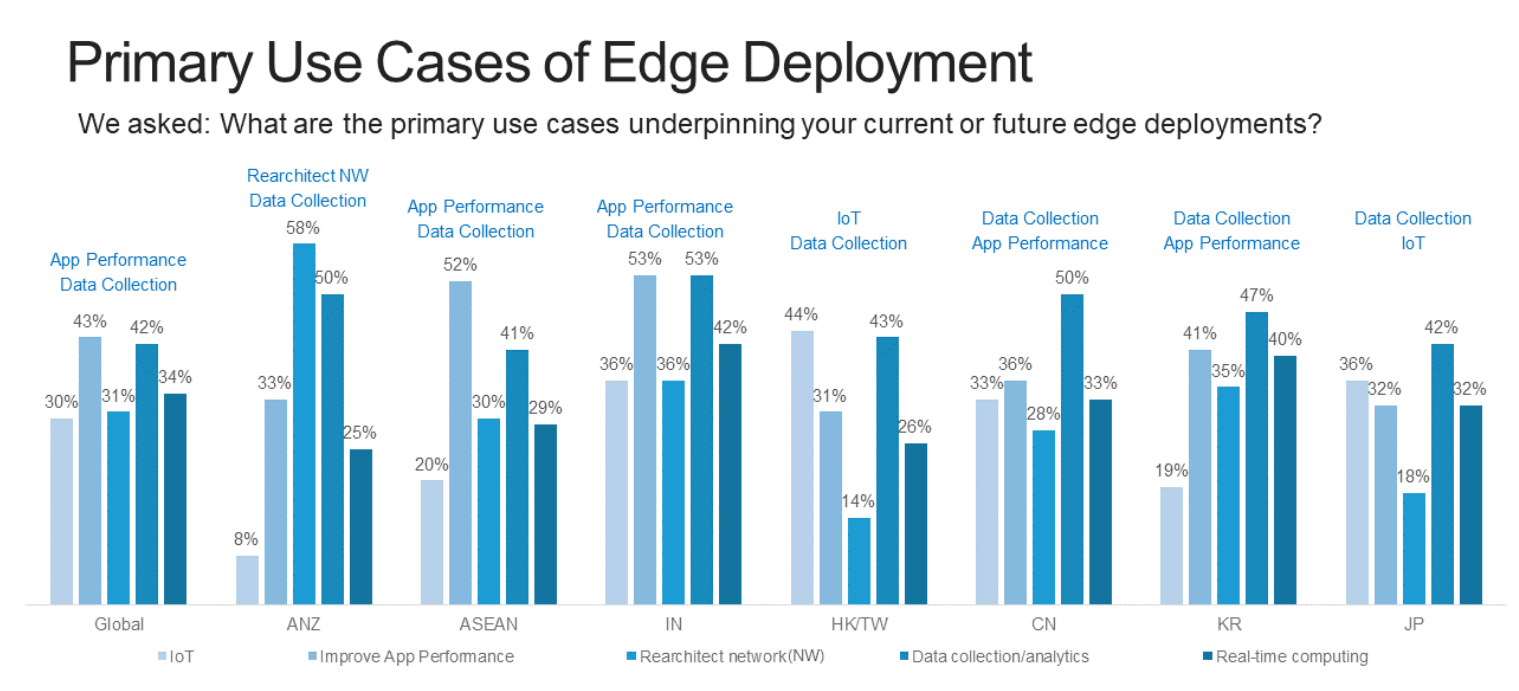Stand der Application : Appetit des asiatisch-pazifischen Raums auf Edge-Computing und App-Modernisierung
Wie viele unserer Kollegen und Branchenexperten seit Anfang letzten Jahres festgestellt haben, erregt der Aufstieg des Edge-Computing weiterhin große Aufmerksamkeit. Analysten überhäuften ihre Vorhersagen mit dem Versprechen von Edge-Computing: IDC prognostizierte, dass Edge-Computing die höchste Priorität für das Jahr 2021 hat , Gartner hob hervor, wie Edge-Computing die Einschränkungen des zentralisierten Computings überwindet und Forrester Research ging davon aus, dass Edge-Computing im Jahr 2021 einen Wendepunkt erreicht .
Dieses Interesse lässt sich im Wesentlichen auf eine wichtige Erkenntnis reduzieren: Die Dezentralisierung der Application auf verschiedene Punkte im Netzwerk bietet unzählige Vorteile. Mit anderen Worten: Unternehmen erkennen, dass ihre Technologielösungen nicht nur in einem zentralen Rechenzentrum oder einer öffentlichen Cloud unterstützt werden müssen, um eine bessere Leistung für ihre Applications und Benutzer zu erreichen. (Randbemerkung: In allen Branchen werden zahlreiche Anwendungsfälle diskutiert, doch ein anschauliches Beispiel, bei dem der Wert von Edge-Computing schnell klar wird, ist die industrielle Automatisierung und Überwachung, insbesondere im Zusammenhang mit Kameranetzwerken, die das Herunterladen visueller Daten und Analysen erfordern. Wenn diese Aufgaben am Rand ausgeführt werden, anstatt die riesigen Datenmengen der Videodateien an einen zentralen Ort im Rechenzentrum oder in der Cloud zu senden, wird die Latenz erheblich reduziert.)
Ebenso stellten wir im Bericht „State of Application Strategy 2021“ von F5 fest, dass mehr als drei Viertel (76 %) der Befragten den Edge bereits nutzen oder dies planen, um Vorteile bei der Application , Leistung und Datenverfügbarkeit zu erzielen. Wir untersuchten außerdem die wichtigsten Anwendungsfälle für den Einsatz von Edge-Computing und kamen zu dem Ergebnis, dass die obersten Prioritäten „Verbesserung der Application “ (43 %) und „Datenerfassung/-analyse“ (42 %) waren.
Bei der Betrachtung der Befragten aus dem Asien-Pazifik-Raum deckten sich die meisten Einschätzungen mit dem weltweiten Feedback. Allerdings stellten wir fest, dass einige Länder andere Prioritäten setzten.
In der Region Australien und Neuseeland (ANZ) sowie in Indien besteht im Vergleich zum Weltdurchschnitt insgesamt ein höherer Bedarf an bestimmten Anwendungsfällen. Bemerkenswerte Ergebnisse aus ANZ zeigen, dass dort Edge-Bereitstellungen als Teil einer Netzwerkneuarchitektur zur Unterstützung von Remote-/verteilter Arbeit betrachtet werden (58 %). Darüber hinaus hat die „App-Leistungsverbesserung“ in der ASEAN-Region eine viel höhere Priorität eingeräumt als im weltweiten Durchschnitt (52 %), während China und Korea mehr an der „Datenerfassung“ interessiert sind (50 % bzw. 47 %). Und nicht zuletzt zeigten die Region Hongkong und Taiwan (HK&TW) sowie Japan einen ähnlichen Trend mit einem stärkeren Fokus auf IoT-Anwendungsfällen (44 %, 36 %). Randbemerkung: Ich gehe davon aus, dass einige gemeinsame Trends zwischen China, Korea, HK&TW und Japan auf die robusten Fertigungsindustrien dieser Regionen, Unternehmen im IoT-Bereich und/oder die Erkundung von IoT-Anwendungsfällen für ihre eigene Fabrikautomatisierung oder -systeme zurückzuführen sind.
Offensichtlich werden Edge-Bereitstellungen durch die Entstehung neuer Applications und die Modernisierung älterer Apps in neue Architekturen vorangetrieben. Das Hinzufügen einer API-Ebene hat sowohl für die weltweiten Befragten als auch für alle Länder im Asien-Pazifik-Raum durchgängig Priorität. Wir haben jedoch eine interessante Vielfalt im Status der API-Bereitstellungsphasen festgestellt, wenn es um die API-Verkehrskontrolle und API-Sicherheit geht.
Weltweit und in den meisten Ländern im asiatisch-pazifischen Raum tendieren Unternehmen dazu, ein API-Gateway einzusetzen, um eine bessere API-Sichtbarkeit und -Kontrolle zu erreichen. Es ist erfreulich zu sehen, dass Regionen wie Australien, Neuseeland, Indien und China über dem globalen Durchschnitt liegen. Was die übrigen Regionen betrifft, so scheinen sie größtenteils mit der globalen Stimmung übereinzustimmen. Wenn es jedoch um den Prozentsatz der bereitgestellten API-Sicherheit geht, sehen wir im Vergleich zum globalen Durchschnitt in fast allen Regionen im asiatisch-pazifischen Raum eine größere Lücke bei den API-Gateway-Bereitstellungen. Insgesamt weist dies auf ein potenzielles Risiko für Unternehmen im Asien-Pazifik-Raum hin: Die Unternehmen treiben die API-basierte Modernisierung voran, um digitale Ökosysteme aufzubauen, messen dem Schutz dieser APIs jedoch immer noch eine geringere Priorität bei. Dies ist noch schwerwiegender und besorgniserregender, wenn es um Open API geht, die offen im öffentlichen Internet veröffentlicht werden. Die einzige interessante Ausnahme besteht darin, dass HK&TW eine sehr geringe API-Gateway-Bereitstellung mit einer höheren API-Sicherheitspriorität aufwies (46 % gegenüber 59 %). Wir sollten das hohe Sicherheitsbewusstsein dieser Region würdigen. Es scheint jedoch, dass sie von einer beschleunigten Nutzung des API-Gateways profitieren würden, da der globale Durchschnitt und die meisten Regionen im asiatisch-pazifischen Raum vor den Ergebnissen von HK&TW liegen.
Zusammengefasst sind die Themen App-Modernisierung, APIs und der Ausbau des Edge-Computing im asiatisch-pazifischen Raum meine Lieblingserkenntnisse aus dem Bericht „State of Application Strategy“ 2021. Aber wissen Sie was? Der Bericht enthält weiterhin zahlreiche wichtige Erkenntnisse und Daten, die Ihnen bei der Entwicklung einer Application zur Modernisierung und Verbesserung des digitalen Erlebnisses Ihrer Benutzer helfen können. Ich empfehle Ihnen daher, Ihr Exemplar noch heute herunterzuladen .

